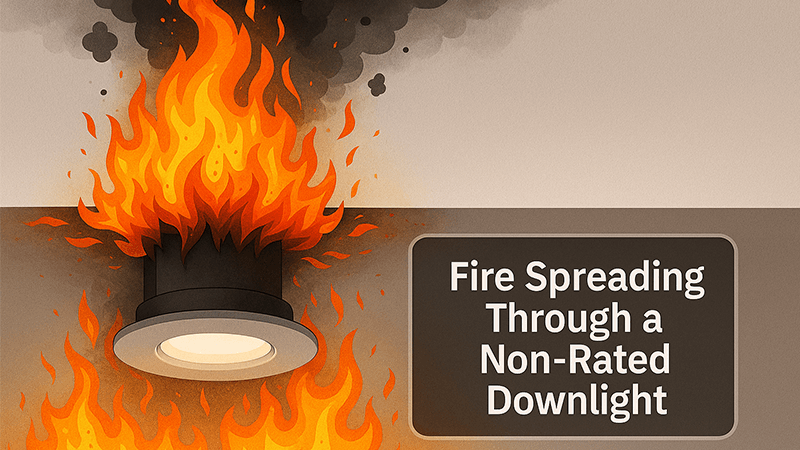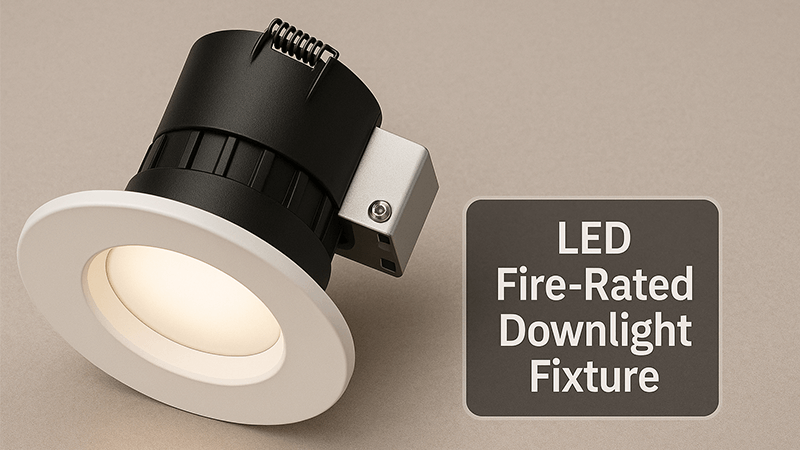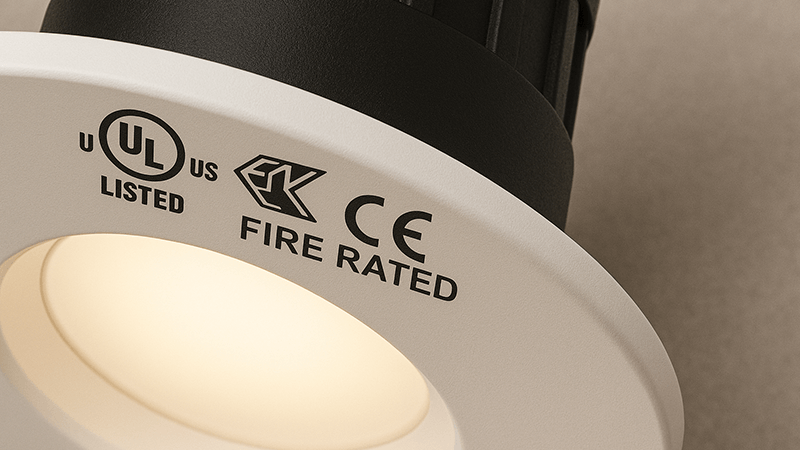Worried about fire safety with recessed lighting? Unsure if special downlights are necessary? I will explain what you really need to protect your building and its occupants.
Yes, you most likely need fire-rated downlights if you install them in a fire-rated ceiling. This is common in multi-story buildings. They maintain the ceiling’s ability to block fire, smoke, and heat, which is a critical safety requirement to protect people on the floor above.

It seems simple, but there’s a lot of confusion out there about this topic. I’ve been in the LED manufacturing business for years, and this question from clients like Shaz comes up all the time. A misunderstanding can have serious consequences, not just for compliance but for people’s safety. Let’s break it down so you can make an informed decision for your projects. Understanding the "why" is just as important as the "what," and I want to make sure you have all the facts.
Do I need to fit fire rated downlights?
Installing downlights creates holes in your ceiling’s fire barrier. These holes can seriously compromise your building’s fire safety. I will help you understand when and where fire-rated downlights are a must-have.
You must fit fire-rated downlights in any ceiling that is also the floor of a room above, like in a multi-story building. This restores the ceiling’s fire barrier integrity. This is often legally required by building codes to prevent the rapid spread of fire.

Let’s dive deeper into where these lights are essential. In my experience, the decision isn’t just about the light fixture itself; it’s about the entire building structure and how every component works together as a system to keep people safe.
Understanding Fire-Rated Ceilings
First, you need to understand what a fire-rated ceiling is. It’s not just plasterboard. It is a complete system designed to resist fire for a specific amount of time. You will see ratings like 30, 60, or 90 minutes. This means the ceiling should be able to hold back fire and smoke for that duration, giving people time to escape. When you cut a hole in this ceiling to install a standard downlight, you break that barrier. You’ve created a direct pathway for flames and toxic smoke to travel to the floor above in just a few minutes, completely defeating the purpose of the fire-rated ceiling.
When are they legally required?
Building codes around the world are very strict about this. For example, in the UK, Building Regulations Part B covers fire safety. The general rule is simple: if a ceiling is located between two separate living spaces, it must maintain its fire rating. This applies to:
- The ground floor ceiling in a two-story house.
- The ceiling of an apartment with another apartment above it.
- The ceiling of an integral garage if there is a room above it.
In these situations, fitting fire-rated downlights is not optional; it is a legal requirement. As a purchasing manager, ensuring compliance is a key part of your job to avoid legal trouble and, more importantly, to ensure the safety of the end-users.
What about alternatives?
Some people ask about using fire hoods or covers over standard, non-rated downlights. While these can work, I generally advise against them for new installations. Integrated fire-rated downlights are designed and tested as a single, reliable unit. They are easier to install correctly and offer more consistent performance. Relying on a separate hood means another component that could be installed improperly, creating a weak point. I always recommend the integrated solution for guaranteed compliance and complete peace of mind.
Do LED recessed lights need to be fire rated?
People think LEDs are cool and totally safe. But does using an LED bulb mean you can skip the fire rating on the downlight fixture? Let’s clear up this common and dangerous misconception.
Yes, even LED recessed lights need to be fire-rated if installed in a fire-rated ceiling. The fire rating is about the fixture’s ability to seal the hole in the ceiling during a fire, not the heat of the light source itself. The LED technology does not change this requirement.

This is one of the most frequent points of confusion I encounter. It is crucial to separate the benefits of LED technology from the structural requirements of fire safety. They are two completely different things. Let me explain this in more detail so there is no doubt.
The Fire Rating is in the Fixture, Not the Bulb
The key point to remember is that the fire rating is a feature of the downlight’s housing, or can, not the lamp inside it. Whether you use a halogen, a CFL, or an LED bulb is irrelevant to the ceiling’s structural integrity. A hole is a hole. A fire-rated downlight is specifically constructed to seal that hole when exposed to fire. It has a special material called an intumescent seal built into its structure. This material is designed to expand rapidly when it gets hot, completely blocking the opening.
How Does the Intumescent Seal Work?
From my insights in manufacturing, this seal is the hero of the product. It’s a strip of material, often graphite-based, that sits around the body of the downlight. Under normal conditions, it does nothing. But when a fire starts and the temperature around the fixture reaches about 200°C (392°F), a chemical reaction happens. The material swells up to many times its original size, turning into a dense, fire-resistant char. This char fills every gap between the downlight and the ceiling cutout, effectively restoring the fire barrier. It stops flames, smoke, and extreme heat from passing through for the rated time, be it 60 or 90 minutes.
A Comparison of Fixture Types
To make it perfectly clear, let’s compare the two options in a fire scenario.
| Feature |
Standard LED Downlight |
Fire-Rated LED Downlight |
| Construction |
Basic metal or plastic housing |
Housing with a built-in intumescent seal |
| Ceiling Integrity |
The hole remains open in a fire |
The intumescent seal expands and plugs the hole |
| Fire Spread |
Allows fire and smoke to pass through in minutes |
Contains fire and smoke to the room of origin for 60-90 mins |
| Compliance |
Non-compliant in fire-rated ceilings |
Compliant with fire safety regulations |
| Result |
Rapid fire spread, less time for evacuation |
Slower fire spread, more time for safe evacuation |
So, when you are sourcing products, always remember: choosing LED is great for energy efficiency and long life. But for safety in a fire-rated ceiling, you must choose a fire-rated fixture.
How do you know if a downlight is fire rated?
You can’t rely on guesswork for fire safety. How can you be sure the downlight you’re buying is truly fire-rated? I’ll show you the clear signs to look for.
Look for official certification marks and fire-rating information printed directly on the product, its packaging, or the technical data sheet. A genuine fire-rated downlight will clearly state its rating, such as "30, 60, & 90 Minute Fire Rated," and have certifications like CE, UKCA, or UL.

As a purchasing manager like Shaz, your reputation and your company’s liability depend on sourcing compliant products. You need to be able to verify claims with confidence. I’ve seen many products in my time, and the reliable ones always have clear, verifiable proof of their performance. Let’s break down exactly what to check for.
Check the Product and Packaging
The most immediate check is physical inspection. A legitimate manufacturer will be proud of their product’s safety features and will display them clearly.
- On the Downlight: Look for markings etched or printed onto the body of the downlight itself. It should specify the fire rating (e.g., "90 Min Fire Rated"). You might also see the model number and certification logos.
- On the Box: The packaging is a key source of information. It should prominently feature the fire rating and the relevant certification marks. Don’t trust a product that comes in a plain, unmarked box.
- The Intumescent Seal: Visually inspect the downlight. You should be able to see the intumescent material, which usually looks like a dark grey or black strip around the can or neck of the fixture. If it’s missing, it is not a fire-rated downlight.
Scrutinize the Documentation
For professional procurement, you need to go beyond the physical product and check the paperwork.
- Technical Data Sheet: This is a crucial document. It will provide detailed specifications, including the exact fire rating standards it has been tested against (e.g., BS 476: Part 21). A reliable supplier like me will always provide this without hesitation.
- Declaration of Conformity: This is a formal document where the manufacturer declares that the product meets all required standards. Ask for it. If a supplier cannot provide this, it is a major red flag.
The Importance of Certification Marks
These logos aren’t just for decoration; they are your guarantee that the product has been independently tested.
- CE Mark: Indicates conformity with health, safety, and environmental protection standards for products sold within the European Economic Area (EEA).
- UKCA Mark: The new UK product marking required for goods being placed on the market in Great Britain.
- UL/ETL Listed: These are common marks in North America, signifying that the product meets standards from Underwriters Laboratories or Intertek.
If a downlight lacks these markings and documentation, you cannot trust its fire-rating claim. Always choose products that provide this clear proof of compliance.
Do LED lights get hot enough to start a fire?
LEDs are known for being cool to the touch. This leads many people to believe they pose no fire risk. But is that entirely true? Let’s look at the facts.
While the light-emitting diode itself runs cool, the electronic components at the base of an LED light get very hot. A poorly designed LED light with inadequate heat sinking can overheat and potentially ignite nearby combustible materials, creating a fire risk.

This is a critical distinction that is often overlooked. In my manufacturing facility, thermal management is one of our top priorities for this very reason. The quality of an LED product isn’t just about the light it produces; it’s about how safely it manages the heat it generates.
Where Does the Heat Come From?
An LED is not 100% efficient. While much more efficient than old incandescent bulbs, a significant portion of the electricity it uses is still converted into heat, not light. This heat is generated in the driver and the electronic components at the base of the LED chip. If this heat is not drawn away effectively, the temperature can build up to dangerous levels. I have seen temperatures on the circuit board of a poorly made LED lamp exceed 100°C (212°F).
The Role of the Heat Sink
This is where the heat sink comes in. The heat sink is the metal, often finned, part of the LED light’s body. Its job is to pull heat away from the sensitive electronics and dissipate it into the surrounding air. The quality and design of this component are vital for both the safety and the lifespan of the LED.
- Good Quality: A well-designed heat sink, usually made of aluminum, provides a large surface area to cool the components effectively, keeping them at a safe operating temperature.
- Poor Quality: Cheaply made LEDs often cut corners here. They might use less material, a poor design, or even plastic disguised to look like metal. These inadequate heat sinks cannot dissipate heat properly, leading to overheating.
The Real Fire Risk
The fire risk from an LED light is not typically from the light beam itself. The risk comes from the base of the unit overheating and coming into contact with flammable materials. Consider these scenarios:
- Insulation: If a non-IC rated (Insulation Contact) downlight is covered with thermal insulation in a ceiling, the heat has nowhere to go. This can cause the LED driver to overheat and potentially ignite the insulation or wooden joists.
- Faulty Wiring: Poor quality manufacturing can also lead to faulty internal wiring or driver components that can short-circuit, arc, and start a fire.
So, while LEDs are far safer than old halogen bulbs which operated at extremely high temperatures, they are not without risk. This is why you must always source LED products from a reputable manufacturer who invests in proper thermal management and safety certifications.
Conclusion
In short, you must use fire-rated downlights in fire-rated ceilings. This maintains safety, meets legal codes, and gives people crucial time to escape during a fire.